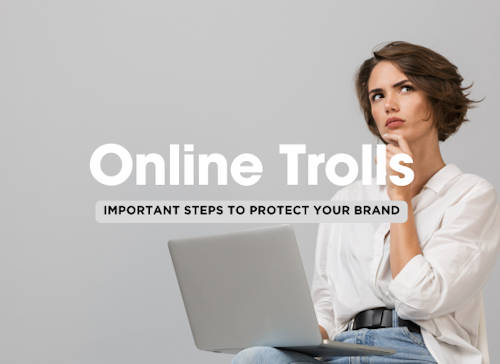In today’s digital landscape, online trolls can pose a significant threat to brands and businesses. These individuals often use social media and review platforms to spread negativity, misinformation, and hostility, which can tarnish your reputation and impact your bottom line. However, effectively managing this behavior is crucial for maintaining your brand’s integrity and fostering a positive online presence. Here are five actionable strategies to deal with online trolls and protect your brand, starting with the first one in detail.
1. Monitor Your Online Presence
🔍 Stay Vigilant and Aware
The first step in combating online trolls is to keep a close eye on your brand’s online presence. Regular monitoring allows you to identify potential trolling activities early and respond promptly.
- Tip:
- Set Up Alerts: Use tools like Google Alerts, Mention, or Brand24 to get notifications whenever your brand name, products, or key personnel are mentioned online. This will help you catch negative comments or reviews as soon as they arise.
- Engage on Social Media: Actively participate in your brand’s social media accounts. Regularly check comments, messages, and posts to gauge audience sentiment. Consider using social media management tools like Hootsuite or Sprout Social to streamline monitoring across multiple platforms.
- Create a Feedback Loop: Encourage your customers to leave reviews and provide feedback. By fostering an open channel for communication, you may reduce the likelihood of trolls since genuine customers feel heard and valued.
- Why It Matters:
Proactive monitoring allows you to stay ahead of potential issues before they escalate. By identifying trolling behavior early, you can develop an appropriate response strategy, minimizing the impact on your brand’s reputation. Quick and thoughtful responses can also demonstrate your commitment to customer satisfaction and show the public that you take their concerns seriously. - Actionable Steps:
- Define Your Monitoring Strategy: Outline which platforms and types of content you’ll monitor (e.g., social media, forums, blogs, etc.). Make sure to assign team members to specific platforms to ensure comprehensive coverage.
- Analyze Patterns: Keep track of when and where trolling occurs most frequently. Look for patterns in behavior—such as certain times of day or specific posts—that may help you anticipate future trolling incidents.
- Document Incidents: Maintain a log of trolling incidents, noting the nature of the comments, responses, and any actions taken. This can help you identify repeat offenders and develop a more tailored response strategy.
2. Establish a Clear Social Media Policy
📜 Define Your Standards and Expectations
Creating a clear social media policy is essential for managing online interactions and setting expectations for behavior on your platforms. This policy serves as a guideline for both your team and your audience, making it easier to handle trolls effectively.
- Tip:
- Define Acceptable Behavior: Clearly outline what constitutes acceptable and unacceptable behavior on your social media platforms. Include examples of trolling, harassment, and abusive language to provide clarity.
- Set Engagement Guidelines: Specify how your brand will engage with followers, including how you will respond to negative comments or trolling. This helps ensure consistency in responses from your team.
- Detail Consequences: Inform your audience about the potential consequences of violating the policy, such as comment deletion or blocking. Make it clear that your brand takes these matters seriously.
- Why It Matters:
Having a social media policy in place helps create a positive online community and establishes your brand’s commitment to respectful interactions. It also empowers your team to take decisive action against trolls, knowing they have clear guidelines to follow. - Actionable Steps:
- Involve Your Team: Collaborate with your marketing, customer service, and legal teams when drafting the policy to ensure comprehensive coverage and practicality.
- Regularly Update the Policy: Review and revise your social media policy regularly to adapt to new trends and challenges. This helps keep your guidelines relevant and effective in addressing current issues.
- Communicate the Policy: Make your social media policy easily accessible to your audience, such as by pinning it to the top of your social media pages or including it in your website’s FAQ section. Transparency fosters trust and encourages adherence to the guidelines.
3. Respond Calmly and Professionally
🤝 Maintain Your Brand’s Integrity
When faced with trolling behavior, it’s essential to respond in a manner that upholds your brand’s reputation. Engaging calmly and professionally can help diffuse negative situations and demonstrate your commitment to customer satisfaction.
- Tip:
- Take a Breath: Before responding to a troll, take a moment to evaluate the situation. Avoid reacting impulsively or emotionally, as this can escalate the situation.
- Craft Thoughtful Responses: Address the troll with a polite and professional tone. Acknowledge their concerns (if applicable) and provide factual information or clarification without resorting to personal attacks.
- Know When to Disengage: In some cases, it may be best to not engage with trolls at all. If a user is clearly seeking to provoke or harass, consider leaving their comments unanswered or using the block feature.
- Why It Matters:
Responding calmly reinforces your brand’s image as a professional and respectful entity. It also shows other followers that you prioritize constructive dialogue and customer satisfaction, potentially dissuading future trolls from targeting your brand. - Actionable Steps:
- Create Response Templates: Develop pre-approved response templates for common trolling scenarios. This allows your team to respond quickly while maintaining professionalism.
- Engage Supportively with Genuine Concerns: If a troll presents valid concerns disguised as trolling, address them with empathy. This shows that you value customer feedback, even when it’s delivered negatively.
- Highlight Positive Interactions: Showcase positive feedback and interactions with genuine customers on your platforms. This can help shift the narrative and counteract negativity.
4. Use the Block and Report Features
🚫 Take Control of Your Online Space
When dealing with persistent trolls, utilizing the block and report features on social media platforms can help maintain a positive environment for your brand.
- Tip:
- Block Offenders: If a user consistently engages in trolling behavior, don’t hesitate to block them from your social media accounts. This prevents them from commenting or interacting with your brand in the future.
- Report Abusive Behavior: Most social media platforms have mechanisms for reporting abusive comments or users. Take advantage of these features to help maintain a respectful online community and hold offenders accountable for their actions.
- Document Incidents: Keep a record of trolling incidents, including screenshots of comments and any actions taken (e.g., blocking or reporting). This documentation can be useful if you need to take further action or if the situation escalates.
- Why It Matters:
Taking control of your online space by blocking and reporting trolls not only protects your brand’s integrity but also creates a safer environment for your genuine audience. It shows that you have a zero-tolerance policy for harassment and negativity. - Actionable Steps:
- Educate Your Team: Ensure that your team understands how to use blocking and reporting features effectively. Provide training on how to identify trolling behavior and take appropriate actions.
- Set Clear Guidelines for Action: Develop a protocol for handling trolling incidents, including criteria for when to block or report users. This ensures consistency in your responses and helps your team feel empowered to act.
- Reinforce Community Standards: Regularly remind your audience of the standards of behavior expected in your online community. This can help deter trolls and foster a more positive environment.
5. Foster a Positive Online Community
🌟 Build a Supportive Environment
Creating a positive and engaged online community can help mitigate the impact of trolls and discourage their behavior. When your audience feels valued and supported, they are more likely to stand up against negativity.
- Tip:
- Engage Regularly: Regularly interact with your followers by responding to comments, asking questions, and sharing valuable content. This encourages active participation and strengthens the bond between your brand and your audience.
- Encourage Positive Interactions: Create campaigns or initiatives that encourage positive interactions among your followers. Consider hosting giveaways, challenges, or Q&A sessions that promote constructive dialogue.
- Highlight Customer Success Stories: Share testimonials, user-generated content, and success stories from your customers. Recognizing and celebrating your community can foster loyalty and a positive atmosphere.
- Why It Matters:
When your brand cultivates a supportive online community, it creates a buffer against trolling behavior. Loyal followers are more likely to defend your brand and report negative interactions, making it easier to manage and reduce the impact of trolls. - Actionable Steps:
- Establish Community Guidelines: Clearly outline the standards for behavior within your online community. Encourage followers to report any trolling behavior and support each other positively.
- Leverage Moderators: If your community grows significantly, consider appointing moderators to help manage interactions and enforce guidelines. This can ensure a consistent approach to maintaining a positive environment.
- Analyze Community Sentiment: Regularly assess the sentiment of your online community through surveys or sentiment analysis tools. This helps you understand how your audience feels and allows you to make adjustments to enhance their experience.



